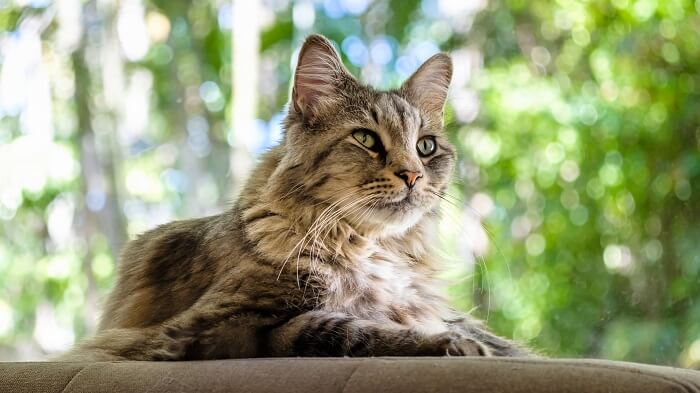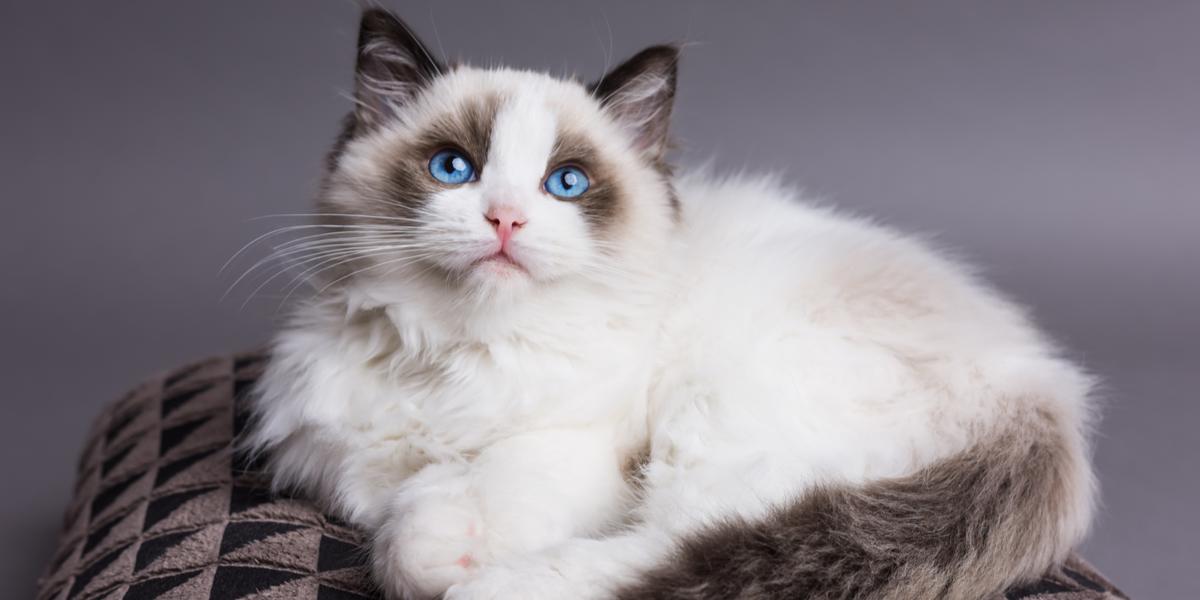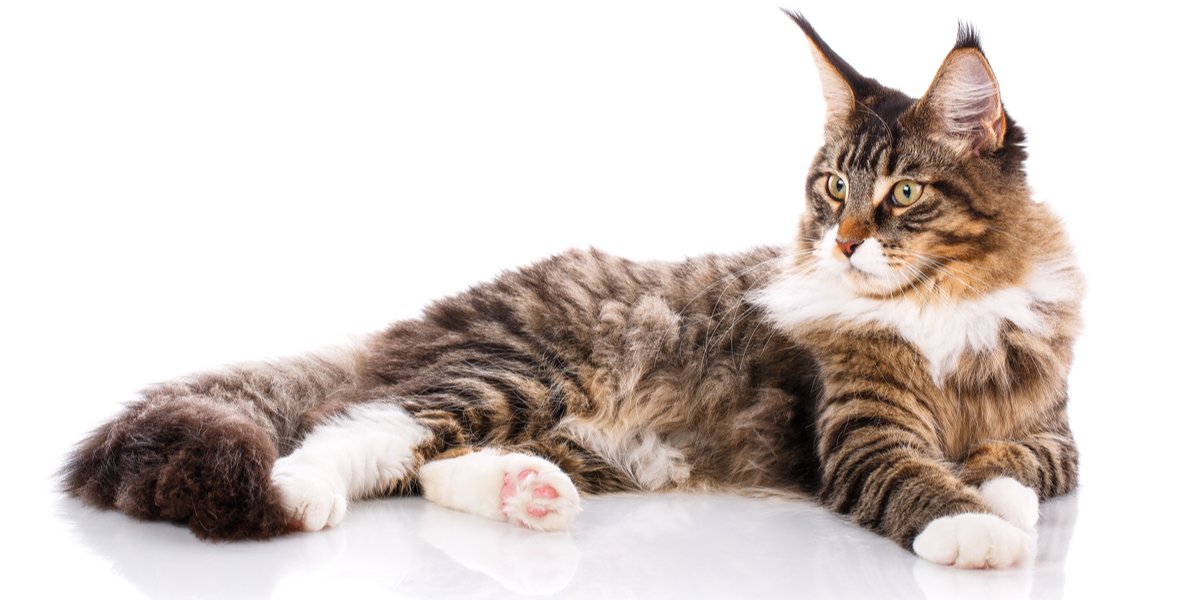
In this article, we’ll get to know the top ten biggest cat breeds on Earth!
At the large end of the spectrum, you’ll find cats that have adapted to cold climates, necessitating big paws and massive tails. Others are distinctively tall and leggy.
Some of the largest cat breeds are domesticated cats little more than a few generations away from their wildcat roots. These exotic hybrids include the Cheetoh, Savannah, and Chausie.
Top 10 Largest Cat Breeds in the World
#1 Savannah
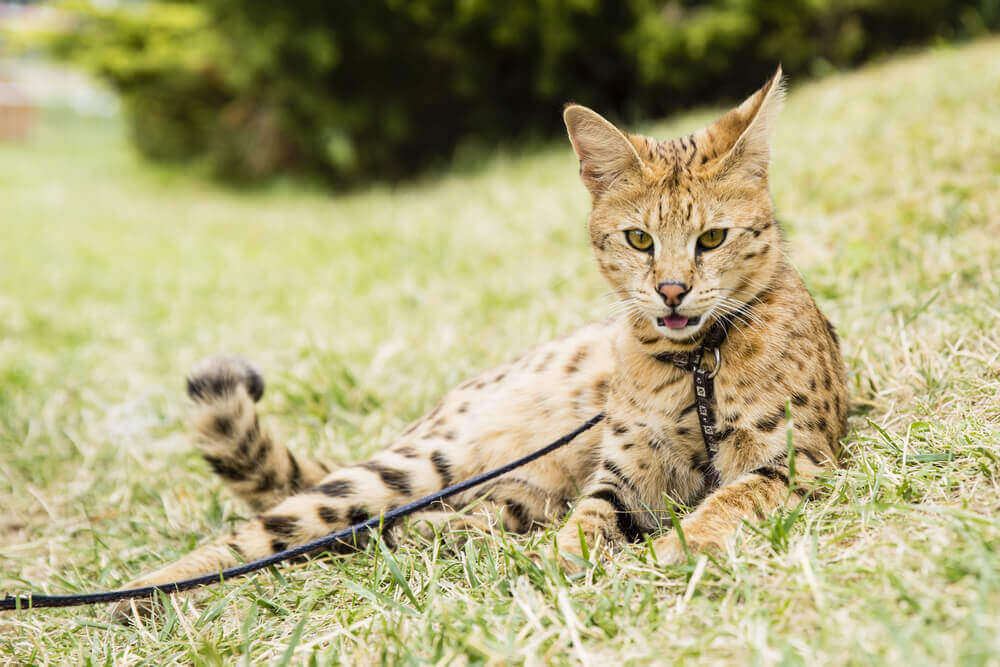
The first Savannah was born in 1986 as the result of breeding between an African serval and a Siamese cat. A true cross is given the filial number F1. Subsequent generations are labeled F2, F3, and so on. Members of the F1 and F2 generation are the largest, thanks to the influence of the serval genetics. These medium-sized wild cats weigh around 26 pounds as adults and some Savannahs reach a similarly high weight.
These cats are densely muscled and leggy, with short spotted coats and large, cupped round ears.
Also Read: 11 Amazing Facts About Savannah Cats
Their energetic personalities and powerful bodies that make them impressively athletic. Savannahs can jump up to eight feet straight in the air. It’s not uncommon for Savannah cats to splash in puddles, play fetch, and go for walks on a leash.
#2 Maine Coon
The true history of this fluffy American native is one cloaked in myth and legend. One tale asserts that the Maine Coon resulted from a cross between a raccoon and a domesticated cat, lending the breed its fluffy striped tail and its name.
Another more genetically plausible origin story involves a terrified Marie Antoinette. Fearing her ultimate demise at the hands of French Revolutionaries, she attempted to travel across the sea with her six favorite Turkish Angora cats. According to the legend, Marie never made it to the States, but at least some of her cats did. Once in New England, the Turkish Angoras bred with local cats and evolved into the Maine Coon.
Another hypothesis holds that the cat may have originated on ships managed by Captain Charles Coone, who traveled in the 1700s from Europe to New England, bringing longhaired European cats like the Norwegian Forest Cat.
This theory holds more weight – the similarity between these Northern European cats and the Maine Coon are striking and match up with the human history of the time.
Regardless of its background, the Maine Coon today is clearly made for harsh, cold environments.
Also Read: 6 Best Cat Foods For Maine Coon Cats
The Maine Coon has the brawn to deal with cold, snowy conditions. Their thick, burly bodies are covered in a lush triple coat that’s thickest on the sides and bottom, protecting them from snow and ice.
Their huge paws are like snowshoes, with tufts of fur between the toes and a tendency towards polydactylism. The Maine Coon’s thick, fluffy tail resembles those found on other animals who evolved for a cold climate.
Known as the biggest house cats, Maine Coons are often referred to as gentle giants. They are relaxed, intelligent, and retain a kitten-like playfulness throughout their lives.
#3 Norwegian Forest Cat
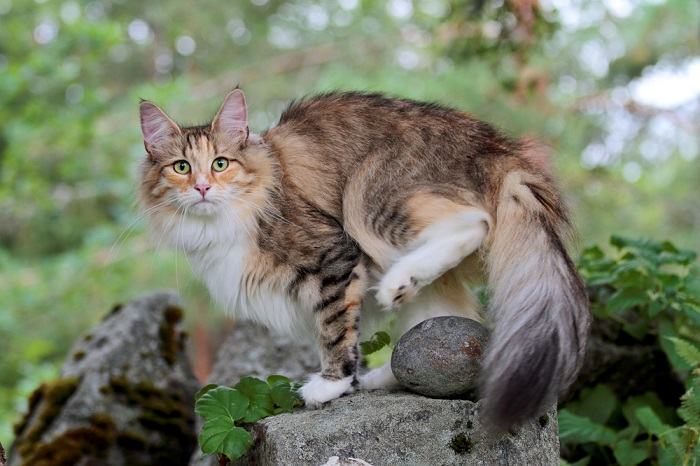
The Norwegian Forest cat is a large, fluffy feline with a long history.
It’s believed that this type of cat was brought to Norway by Vikings in 1000 AD. This fluffy, powerful feline has appeared in European folktales and other texts for hundreds of years. Norse legends describe a “fairy climber”, scaling rock faces like no other cat.
Indeed, the Norwegian Forest Cat does possess unusually strong claws and can climb trees and rocks with ease.
Like other thick-coated, burly cats, this breed’s physique is adapted to cold Norwegian weather. They have a triangular head, almond-shaped eyes, and a fluffy lion-like scruff.
#4 Ragdoll
Like a ragdoll that dangles limply from your arms, the Ragdoll cat has an interesting tendency to melt when carried.
Ragdolls were first developed in 1963 when a white Angora cat was bred with cats bearing Siamese-style points. This breeding is apparent in today’s Ragdoll. They have thick, fluffy cream point coats.
Also Read: Best Cat Food For Ragdoll Cats
Also like a ragdoll, this breed makes a soft, gentle companion. They’re known for affectionate personalities. Paired with their fluffy coat and tendency to almost ooze down through your arms, the Ragdoll could be considered the ideal cat to snuggle with.
#5 Chausie
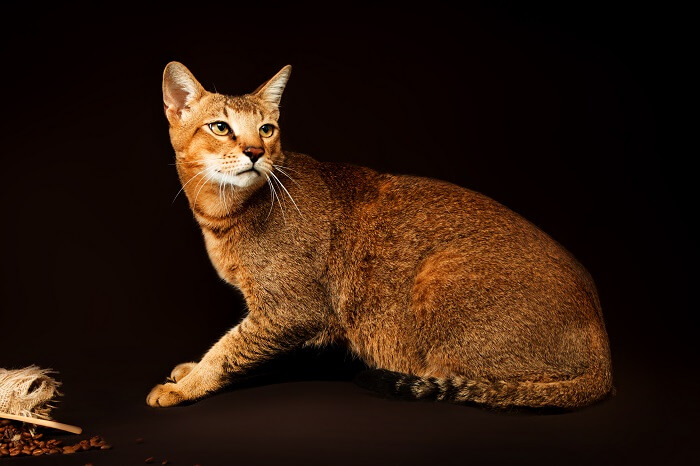
This domestic – wildcat hybrid is made from the breeding of the Felis Chaus with domesticated breeds including the Abyssinian and Oriental Shorthair. Like many other domesticated – wild cat hybrids, the Chausie is a relatively new breed that was developed in the 1990s.
They’re lanky, muscular cats with exceptionally long legs. Their height is an impressive 14-18” at the shoulder.
In addition to a wild appearance, they retain the jungle cat’s passion for adventure. The Chausie personality is active, intelligent, and sociable, and they’re best suited to experienced, passionate owners who can dedicate time to an energetic and headstrong feline.
Their long, powerful bodies are contrasted by a strikingly short tail. Their coats are typically a tawny agouti, although some Chausies have a black or unique grizzled black coat.
#6 Turkish Van
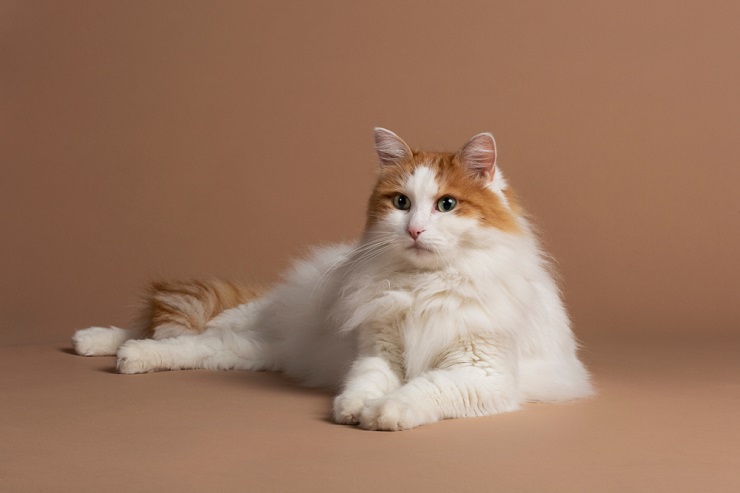
This big and beautiful breed originated in the Armenian Highlands of modern-day Turkey. Their primary distinguishing feature is the Van pattern which is named after the breed. This pattern involves color restricted to the head and tail while the body of the cat is white. This coloring is a type of partial leucism caused by the expression of the piebald white spotting gene.
Another unique characteristic you’ll see in many Turkish Vans is heterochromia – having two different colored eyes. They are a medium-to-large breed with males weighing 10 to 20 pounds and female weighing 7 to 12 pounds. They are also a slow-maturing breed, often taking 3 to 5 years to reach full maturity.
Also Read: Turkish Van Breed Profile
Turkish Vans are considered semi-long-haired but, unlike many breeds with longer coats, they have no undercoat. This gives their coat an ultra-soft, cashmere-like texture and appearance. The coat is unusually water-repellant which makes bathing a challenge but the fur does dry quickly.
These cats are known for their high intelligence and playfulness. Turkish Vans can be somewhat mischievous, and they love to climb. Though they can be very social and may get along with children, they tend not to be lap cats and may not appreciate handling as much as other breeds.
#7 Bengal
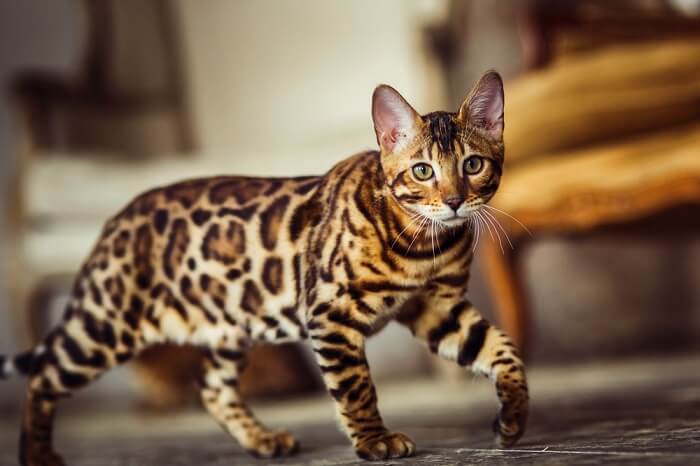
Much like the Savannah cat, the Bengal is the result of crossbreeding domestic cats with wild cats. The breed was originally discovered by Jean Mill, a California breeder, who bred domestic shorthairs with Asian leopard cats. Though she didn’t initially set out to develop a new breed, she was the first to make the crossing. Around that same time, Dr. Willard Centerwall at Loyola University was experimenting with crosses between Asian leopard cats and domestic cats.
Bengal cats have a distinctly wild appearance similar to the Savannah cat. They are easily recognized by their golden, patterned coats. The breed exhibits a varied pattern of spots, marbling, rosettes, and arrowhead markings.
Also Read: Best Owner’s Guide to Bengal Cats
Not only are Bengal cats striking in their appearance, but they are a gregarious and energetic breed. Bengal cats are highly intelligent and can sometimes be challenging to keep out of trouble. They are a confident, alert breed that enjoys games and can be taught tricks.
It isn’t uncommon to find Bengal cats playing in the tub or perched on the highest surface in the house. These cats are often said to shed less than other breeds, though there is also a longhaired version of the breed sometimes known as the Cashmere Bengal.
#8 Siberian
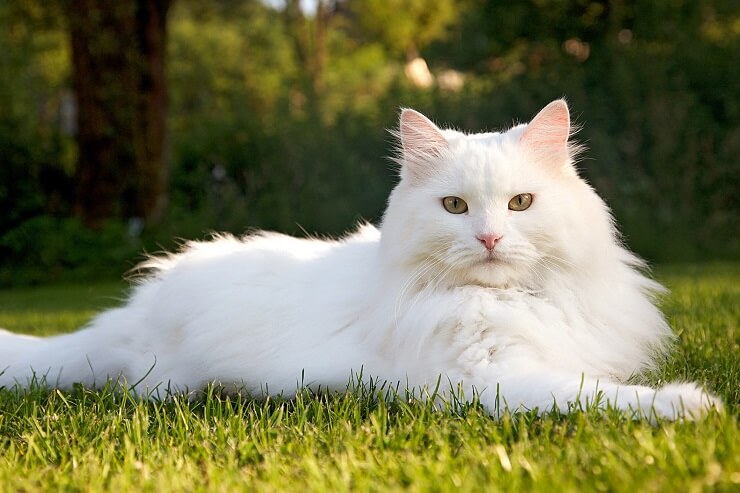
The Siberian is a landrace of domestic cat that originated in Russia. Though the breed itself is centuries old, it has only been developed as a formal breed with standards since the 1980s.
Siberians are medium-to-large cats with males weighing 15 to 20 pounds and females slightly smaller. They are also known as Siberian Forest Cats or Moscow Longhairs.
Siberians have a thick coat that consists of three natural layers: guard hair, awn hair, and down hair. These hardy layers help protect the cat from cold weather in Russia, but the coat is still relatively easy to care for. Its glossy texture helps to reduce matting, though the breed does molt once or twice a year.
Also Read: Siberian Cat Diet – Feeding Your Siberian the Right Way
The Siberian cat breed is adventurous by nature, but these cats generally have easygoing personalities. They like active households with children and other pets, though they may bond more closely with one person from the household. They can also be quite talkative, expressing themselves with trills, chirps, and quiet meows along with plenty of purring.
#9 British Shorthair
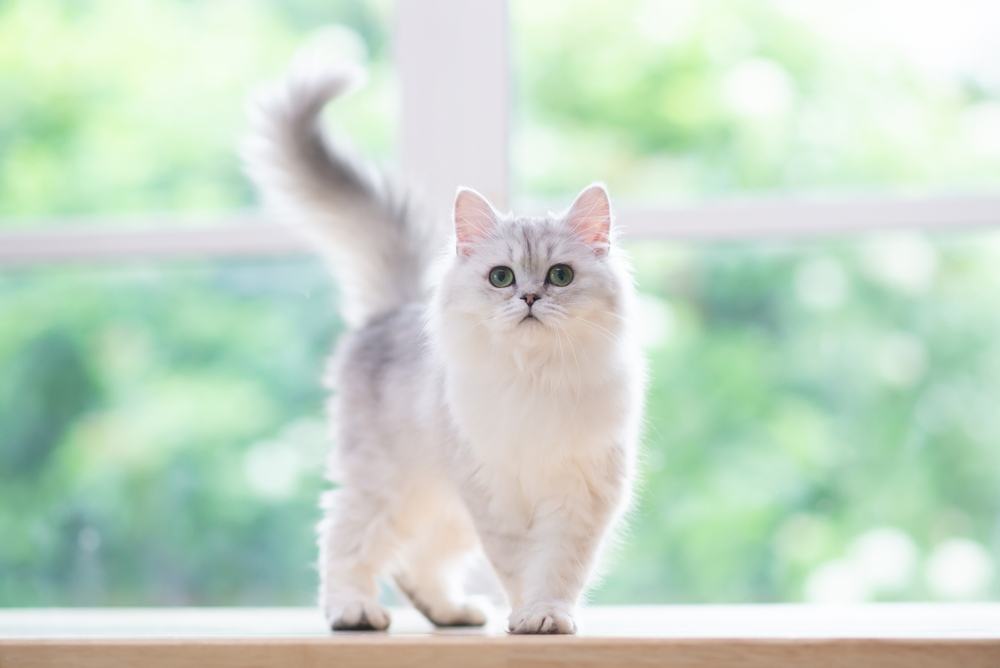
Known for their friendly and easygoing nature, British Shorthairs are an affectionate breed. These cats can become quite attached to their owners and, while they generally aren’t fond of being carried, they like to spend time in proximity with their people.
The British Shorthair was likely developed in the first century AD, originally imported to Europe by the Romans. The cats eventually bred with local European wildcats and developed over the centuries into large, robust cats with thick coats.
Also Read: Best Cat Food for British Shorthairs
Males of the breed generally weigh 9 to 17 pounds while females are a little smaller, between 7 and 12 pounds. British Shorthairs, unsurprisingly, have short coats but the fur is very thick and plush. Blue is the most common color for the breed, but they also appear in black, white, red, cream, silver, and gold as well as color point and tabby patterns.
British Shorthairs don’t tend to be as playful as other cat breeds, but they are very devoted to their families. They require minimal grooming and don’t tend to be overly vocal cats.
#10 American Bobtail
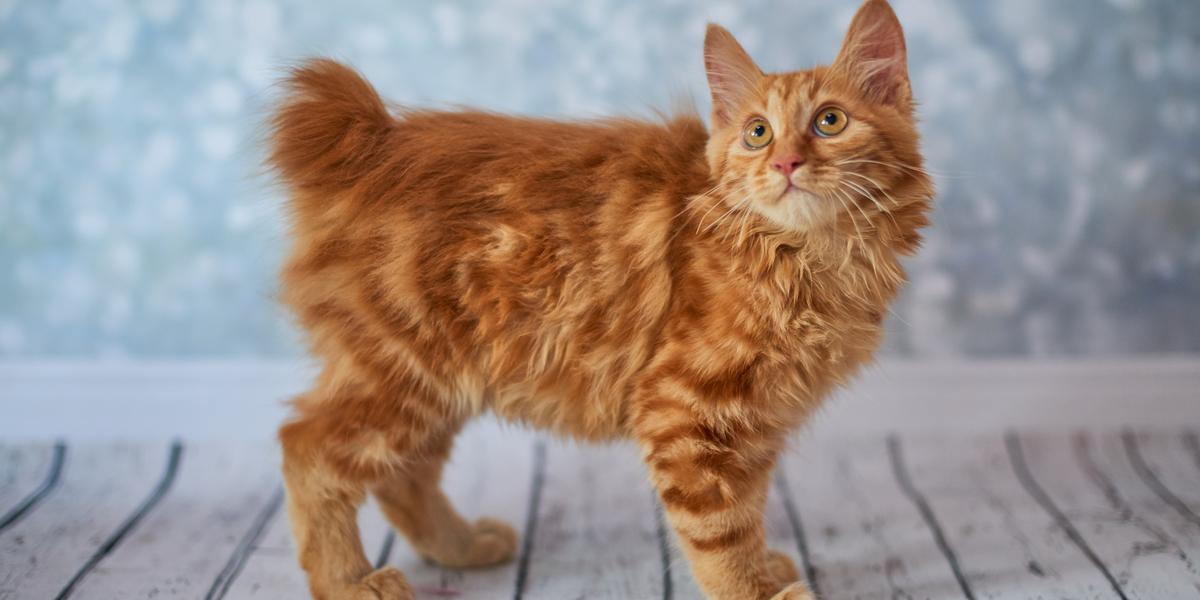
Aptly named for its short, stubby tail, the American Bobtail is an intelligent and active cat with a wild appearance. These cats are a fairly rare breed, having only been developed in the late 1960s. They get their unique bobbed tail from a genetic mutation, similar to the Manx cat breed.
American Bobtails are said to be the result of a crossing between a domestic tabby cat and a wild bobcat. The more likely origins, however, involve feral domestic cats born with bobbed tails. John and Brenda Sanders are credited with making some of the first known attempts at breeding after they found a feral bobtail cat while vacationing in Arizona.
Also Read: American Bobtail Cat Names
The American Bobtail has a sturdy appearance with a somewhat shaggy coat. Their bodies are moderately long but stocky and the torso full and broad. American Bobtails have large, round feet and broad wedge-shaped heads with wide-based ears.
This breed is social and playful and reportedly clever enough to open closed doors and escape from secure crates. They aren’t afraid to ask for attention and they are highly adaptable to new environments, making them a great choice for travelers.
How Big Is the World’s Longest Domesticated Cat?
In the Guinness Book of World Records, the world’s largest cats are determined by length rather than weight.
Currently, the world’s longest living cat is a Maine Coon named Ludo, who measures 118.3 centimeters or 45.6 inches long!. From nose tip to the end of his tail, Ludo is about as long as the average six-year-old human is tall. The longest cat ever was also a Maine Coon. Stewie measured 123.19 cm or 48.5 inches long.
How Big Is the World’s Heaviest Domesticated Cat?
Although the world’s largest cat breeds are above average in weight, any cat can be obese. Therefore, the world records tend to go to overweight cats rather than exceptionally large breeds.
To discourage people from feeding their cats into obesity and disease for the sake of stardom, the world’s heaviest cats are no longer recorded in the Guinness Book of World Records.
The heaviest cat on record died at age ten in 1986. At the time, Himmy weighed 21.3 kg or 46.8 lbs
